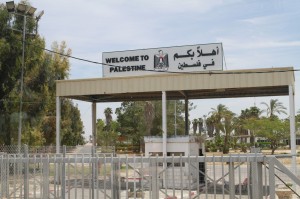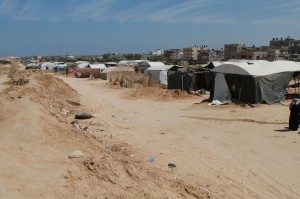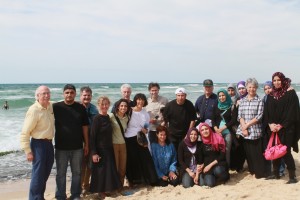Guest blog by Gerri Haynes: A visit to some of the many tunnels of Gaza
As she did last year, Gerri has organized a Washington Physicians for Social Responsibility delegation of doctors and other health care providers to work in hospitals and clinics in Gaza in an effort to directly help the people there and to bring attention to the ongoing humanitarian crisis that the Israeli blockade has created. She will be sending back reports from inside the Israeli blockade.
And so to the tunnels.
This is Friday, day of worship in the Muslim world. For our group, a day of rest and a time to take a wider look at the country we are visiting.
We traveled in a large bus with our hosts and friends from the northern border with Israel to the southern border with Egypt.

The crossing between Egypt and Gaza at Rafah. (Bob Haynes photo)
Along the way, we noted the areas where Israeli settlers once lived. In 2005, approximately 5,000 Israelis were evacuated from Gaza – moved by Israel to different homes in the Occupied Territories and Israel.
We learned that, while all of the settler homes were destroyed by Israel when Israel left Gaza to become an external occupier, several lovely schools and most of their greenhouses were left standing. Rubble from the destroyed houses has been cleared from the settler home sites – in part, at least, to use one day in the construction of a port.

Land of the Tunnels: Each structure covers a tunnel. (Bob Haynes photo)
Basic necessities and many other items come through the tunnels: water, cloth, cars, motorcycles, building materials, camels, goats – almost any item that can claim a price. Several times in the last few days, we have seen shiny new cars in Gaza – successful navigators of the tunnels. Even brides have arrived in Gaza through the tunnels – carried sleeping through the underground passage.
While we visited the tunnels, we heard an explosion – we were told this came from the Egyptian side and was probably the destruction of a tunnel – its hiding place found. The tunnels are not legal.
As we traveled north to our hotel in Gaza City, we stopped to enjoy the Mediterranean Sea – with waters too polluted for swimming, the sites and sounds of the sea remain lovely. We shared lunch, games and conversation, then drove along the Sea to stop once more for ice cream and then to say farewell to our hosts.

Seattle delegation and friends by the Mediterranean. (Bob Haynes photo)
Tomorrow is another day for work.
RSS feed for comments on this post. TrackBack URI